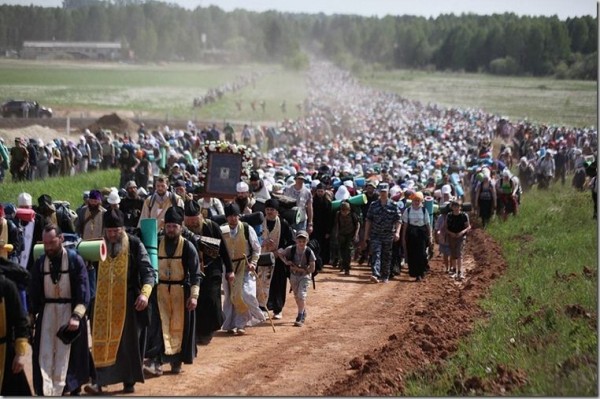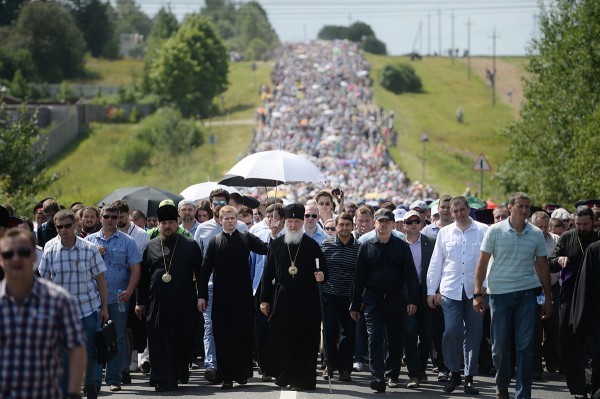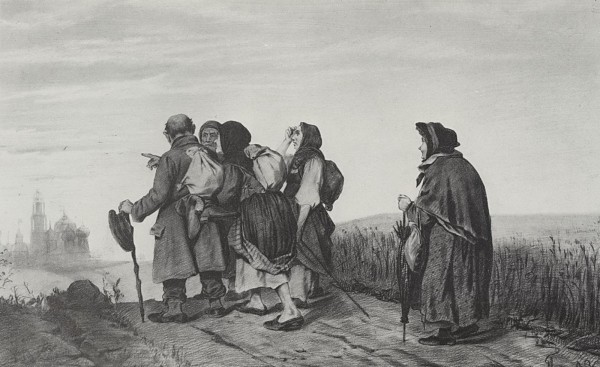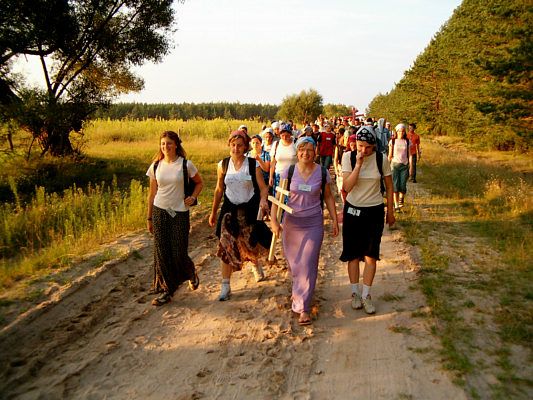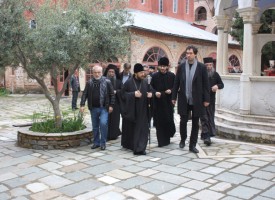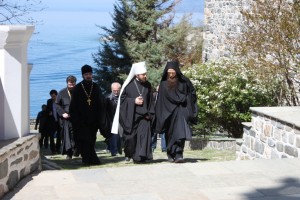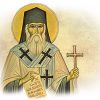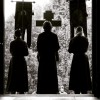In October of 1888 the Grand Duchess Elizabeth, not yet an Orthodox Christian but still a Lutheran, went on pilgrimage to the Holy Land with her Russian Orthodox husband, the Grand Duke Serge Alexandrovitch. From Jerusalem she wrote the following to her grandmother, Queen Victoria of Britain:
“My very dear Grandmama,
“All our journey we have had very little time for writing letters, but having a quiet morning I use the opportunity of sending you a few lines from this Holy Town. It is such an intense joy being here and nay thoughts constantly fly to you all, praying God to bless you with every possible blessing…. It is such a dream to see all these places where Our Lord suffered for us and such an intense comfort to have been able to come to Jerusalem …. one can quietly pray and recall all that, as a little child, one already heard with such religious awe.” (Quoted in Lubov Millar, Grand Duchess Elizabeth of Russia: New Martyr of the Communist Yoke)
In today’s world, especially in Europe and America where there is a certain amount of affluence, individuals and families do not go “on pilgrimage”; they “take vacations.” They go skiing, or they go to Disneyland, or they travel as tourists to see some interesting — but usually non-Orthodox, non-religious — places and sites. Our forefathers in the old countries, however, knew nothing about such things as vacations; they only knew about pilgrimages. They lived longing for the day when they could go on a pilgrimage to the shrine of some wonderworking icon or a saint. This was their concept of a vacation — something that would nourish the soul rather than give rest to the body, for the body, they knew, would soon disappear into the grave, when the soul would go on into eternity and there find its reward or punishment, according to the way of life it had led with the body on this earth.
The title of this article is “What is a Holy Pilgrimage?” Such a title suggests that there is such a thing as a “holy” pilgrimage as opposed to an “unholy,” profane, or secular journey.
The English word “holy” comes from the Middle English, halig, which is derived from the Old English, hal (hail), which means “whole” or complete, not divided or broken up. This seems to reflect the Savior’s own command to us, that we be perfect, even as your Father Who is in Heaven is perfect (Matt. 5:48). He could as well have said, “Be ye holy, even as your Father Who is in Heaven is holy.” Or “Be ye whole…” (Our English word “heal”–as when the Lord healed the paralytic–comes from exactly the same Old English term for “whole” and “holy.”) So, by “holy” we commonly mean something or someone that is exalted or worthy because it is perfectly good and righteous or filled with virtue. We also use the word “holy” interchangeably with “divine” or “heavenly”; thus, we say “Holy God,” or “the Most Holy Mother of God.” A less common but very useful word is “hallow,” which also comes from the same root as holy and whole, but means something that has been made holy or is set apart for holy use. Thus, we sometimes speak of a shrine as a “hal1o,,, ed place.”
All of these words –whole, heal, hailow–are therefore closely related in English to our word “holy.” The whole aim of our life is to become holy, that is to become saints, to achieve union with God. Now we come to the word “pilgrimage.” This word comes from the word “pilgrim”; for our purposes a pilgrim is one who journeys to a shrine or holy place, perhaps the shrine of a saint, or a church containing a great wonderworking icon, or a monastery. This word derives from the Latin peregrinus, which means “foreigner,” and from this we get our fine old English word, “peregrinate,” seldom used nowadays, which means simply to walk or travel, especially on foot. A “pilgrimage,” then, is the journey or path that a pilgrim takes to a shrine or sacred place. It can also refer to the course of our life here on earth, about which I’ll speak more in a moment.
When we talk about a “holy pilgrimage,” we mean, then, some activity or behavior or action–namely, going somewhere very special in a churchly sense, a place that is very holy and tends to draw us towards grace, towards God and towards goodness. It is a movement forward, ultimately in the direction of God. A holy pilgrimage is something which is “set apart” and different from our normal day-to-day activities; it is supposed to be something “other-worldly.” Bishop Ignatius Brianchaninov, in his book, The Arena, tells us that the term “world” means “those people who lead a sinful life opposed to the will of God, who live for time and not for eternity.” Quoting Saint Isaac the Syrian, Bishop Ignatius also explains that “when we wish to call the passions by a common name, we call them the world.” He further explains that “the passions are the following: love of riches, desire for possessions, bodily pleasure.., love of honor which gives rise to envy, lust for power, arrogance and pride of position, the craving to adorn oneself with luxurious clothes and vain ornaments, the itch for human glory which is a source of rancor and resentment, and physical fear …. In brief,” he points out, “the world is the carnal life and the carnal mind.” And it is precisely this which the pilgrim flees, which the pilgrim seeks to turn his back on.
The well-known Orthodox spiritual classic, The Way of a Pilgrim, offers a prime illustration of “holy pilgrimage.” “By the grace of God,” declares the pilgrim in the book’s opening lines, “I am a Christian, by my deeds a great sinner, and by calling a homeless rover [or pilgrim] of the lowest status in life,.” At the beginning of the second chapter, this same pilgrim explains: “I roamed about through many different places for a long time with the Prayer of Jesus as my sole companion…. I thought that I would travel in the great silence of Siberian forests and steppes in a manner that was more suitable for praying and reading …. “Thus, blissfully happy, I spent more than two months of the summer” His was a pilgrimage not just to holy places, but a journey or pilgrimage inward, through prayer.
A more traditional pilgrimage is described at length in the classic medieval work, The Canterbury Tales by Geofferey Chaucer, who describes a group of people on pilgrimage to Canterbury in England m order the venerate the reliquary shrine of the martyred Roman Catholic bishop, Thomas Becket. Although Becket lived after the Great Schism, the pilgrimage probably had many elements in common with pre-Schism pilgrimages in England and elsewhere.
In Orthodox Christian cultures, countries, and civilizations, making a pilgrimage was always something of paramount interest to the faithful, from the highest in the land to the lowest. For example, the Empress Elizabeth Petrovna (1709-1762) loved to visit on foot the various churches of Moscow and the surrounding region. She would, “now and again”-but particularly during Great Lent –“be overtaken by such a surge of piety that she would gather a modest entourage of a few score servants and ladies of the court and, with suitable escort from the guards regiments, make an extended pilgrimage to one of the major outlying holy places such as the vast walled fortress-monastery of Holy Trinity-Saint Sergius…” (Robert Coughlan, Elizabeth and Catherine, Empresses of All the Russias).
Not only the court, but the pious laity went on pilgrimage: “Pilgrimage has always formed an important part of Russian religious life …. There were those who set out on a pilgrimage lasting a year or two and then returned to their former lives and work. There were those whose pilgrimages were brief and infrequent, and there were those who became [holy wanderers], having renounced the ordinary life of a householder entirely.” (Henri Troyat, Daily Life in Russia Under the Last Tsar)
What were the reasons or motives for these holy pilgrimages? A pilgrimage “was sometimes undertaken as a ‘self-imposed’ penance, sometimes as an act of thanksgiving, and sometimes simply as an act of worship or out of a desire for enlightenment.” It involved “a natural humility, lowliness, and asceticism…. Generally [the pilgrim] was silent, but when questioned he would tell of churches, monasteries, tombs of saints, and icons of special sanctity which he had seen; he would tell of saints and sinners, of spiritual life and spiritual death, of both common and extraordinary incidents along the road.” (Ibid.)
One would have seen an “incalculable number of pilgrims who trod the roads” in old Russia. “There were few without an ambition to visit the Petchersk catacombs at Kiev or the lavra of the St. Serge Trinity …. Having left their distant villages with a few kopecks in their pockets, they traveled on foot for weeks or months…sleeping under the stars or in a shed beside a monastery door. Distance did not frighten them. Some of them crossed the whole Empire, from the western frontiers to the heart of Siberia, or front the batiks of the Dnieper to the shores of the Baltic. The most courageous of them,” Troyat continues, “went down to Odessa and embarked in the hold of some old tub sailing for the Holy Land…. Men or women, most of them were realizing a long cherished dream and did not doubt that they would be recompensed at the end of the journey. On their way they collected alms for the construction of a church or for themselves…. As to the monks [of the monasteries and shrines], they had scarcely enough candles, small icons or consecrated bread [antidoron] to satisfy [the great numbers of pilgrims]. The pilgrims slept in huge barrack-rooms, ate at the common table, attended divine services, drank the holy water from a fountain … leaned trembling with fear over the sarcophagus [of a saint] covered with red velvet, kissed the golden cross which was placed on these remains, and went away lit to the depths of their souls.” (Troyat)
Not infrequently, pilgrimages have served as a catalyst for conversion. The Grand Duchess Elizabeth’s pilgrimage to the Holy Land was pivotal in her spiritual development and growth. Her husband, the Grand Duke, had never pressured her to convert to Orthodoxy, but from the very beginning she felt strongly attracted to the Faith. During the return trip to Russia, and for a while afterwards, she reflected deeply on all the events and experiences of he- pilgrimage and on the whole question of Orthodox Christianity itself. In order to convert, she had to overcome the objections of many of her own Protestant family members–in particular her staunch Lutheran father–but the pilgrimage to the Holy Places in Palestine had given her courage and so, eventually, she did convert, although she had do so without the approval and blessing of her father.
How much all of this sober and earnest spirit contrasts with the way in which most of us modern Orthodox Christians make pilgrimages today, especially in the West! Most of us suffer very little or no inconvenience of any kind. We certainly do as little walking as possible. We can get in a car and drive across the country to the reliquary shrine of Saint John Maximovitch at the cathedral in San Francisco, staying in comfortable motels along the way and eating in quite tolerable restaurants, or we can fly across country or across the ocean. We will continue to have our three square meals a day and get sufficient rest, being deprived of nothing other than the convenience of being in our own homes. If there is any kind of stress at all it will be in the form of worrying perhaps about whether our flight will arrive on time or how long we might have to stand in the Divine services. This, of course, is all profoundly worldly and alien to the idea of a true “holy” pilrimage. This is why we must have an understanding of the “inner” pilgrimage, the pilgrimage within our hearts, so that even though our outward pilgrimage may be relatively comfortable and worldly, we are still keeping the proper spirit of a pilgrimage to our hearts and souls. We must all make a sacred journey to the Kingdom that is within us, for the Lord Himself tells us, the Kingdom of God is within you (Luke 17:21) To get to that Kingdom requires a journey, a path, a pilgrimage.
Great Lent is itself a Holy Pilgrimage, as are each of the other holy fasting seasons of the year: Nativity Fast, Apostles Fast, Dormition Fast). It is a pilgrimage not perhaps in space, from one place to another, but certainly a pilgrimage in time and spirit, a pilgrimage that makes use of certain bodily and spiritual practices or “works” such as fasting, vigils, and standing at long services, prostrations and, as far as possible, greater silence or quietness in our lives, both outwardly and inwardly. In such a pilgrimage we are going not only from this world to other worldliness, but we are traveling from the world of sin and death to the world of resurrection and transfiguration; we are swimming a spiritual and psychological sea in order to arrive, finally, at the safe and all-bright harbor of our Lord and God’s Resurrection, Pascha.
An essential key to making a successful pilgrimage, whether an outward or an inner pilgrimage, is repentance. We all of us at one time or another, to one degree or another, feel some sorrow or regret about our sins and failings. But true repentance is much more than regret. In the lives of the saints, the experience of authentic repentance is like a moment of awakening from the sleep of this life of sin. It marks a decisive change in their lives because repentance means not just passing regret or temporary sorrow, but a genuine and complete change of mind or a change of direction in one’s life itself; it is “a sudden shift of the center of gravity of one’s total being from the material to the spiritual, from the physical world to God, from concern for the body to concern for the soul.” (Constantine Cavarnos, Paths and Means to Holiness)
This is a turning inwards rather than a turning outwards, a turning from other people and things and events to one’s own soul; it is a pilgrimage to the Kingdom of Heaven which is within us. As Saint Peter of Damascus says: “One ought to meditate on the name of God more often than one breathes, at all times and places, gathering the mind from all worldly thoughts.” (Quoted in Cavarnos, Ibid.) This kind of profound experience of repentance leads naturally to the Sacrament or Mystery of Confession, and proper preparation for Confession, as we all know, is one of the important things that we do in connection with any kind of pilgrimage, whether inward or outward, Very often the pilgrims of old went on pilgrimage specifically iii order to find some good priest or wise eider to whom they could make the confession of a lifetime, the kind of confession that literally would open up wellsprings of repentance from within. Without seeking this spirit of repentance, a pilgrimage is barren and stillborn, without fruit, not satisfying to God or to our own human hearts.
Above all, then, we must be cultivating a spirit of repentance, asking God for this grace, and treasuring it when we receive it, even if we only catch little glimpses of it. How often we see in the lives of the saints that this or that righteous man or woman lay dying, surrounded by family or disciples, and expressed his profound sorrow not because his life was coining to an end, not because he would no more see the sunrise or sunset, or enjoy good food, hard work, or the conversation of friends, but because he did not have more time left in which to repent. For him the pilgrimage of this life was now ended.
Finally, a Holy Pilgrimage requires taking steps and going forward, either with the body or with the heart and soul or, when possible, with both. When we take steps forward it is always best if we have a map, if we have someone elm, someone trustworthy, in whose footsteps we can follow. For us, a pilgrimage map is provided by the Church. This “map” for our pilgrimage is like a battle plan. “When the map lies open before all … the age is one of spiritual flowering …. [and] when the map is ignored, as it often is today, even by many Orthodox Christianss.. the age is bleak, and Orthodoxy is seen to stumble about as a blind man groping for guidance.” (John Dunlop, Staretz Amyrosy) On this map the path we must follow is clearly marked, and the footsteps we must follow are those of the saints, beginning with our own patron saints. To transform a “good” pilgrimage into a “Holy” Pigrimage requires that we leave our self-centeredness — which is our old baggage or luggage, behind and that we not become attached to new worldly cares or baggage along the way, no matter how important or attractive these things may seem at the moment. During any other kind of pilgrimage, we nanst struggle to keep our hearts from anything and anyone that does not lead us to God. ” This is the lesson we can learn from the great Orthodox pilgrims of old, those for whom the whole of life was one zealous and focused pilgrimage – the journey from this life to the next, from earthly life to eternal life.












